Fetal Non-Stress Test (NST) > Maternal & Newborn
Exam Review
More questions
Total Questions : 14
Showing 14 questions, Sign in for moreA nurse is caring for a client who is pregnant and undergoing a contraction stress test (CST).
The nurse observes three uterine contractions in 10 minutes, with no late or significant variable decelerations of the fetal heart rate (FHR).
How should the nurse interpret this finding?
Explanation
Negative CST.A negative CST means that there are no late or significant variable decelerations of the fetal heart rate (FHR) during three uterine contractions in 10 minutes.
This indicates that the fetus is well oxygenated and can tolerate the stress of labor contractions.
Choice A is wrong because a positive CST means that there are late decelerations of the FHR with 50% or more of the contractions.
This suggests that the fetus is at risk of hypoxia and may need early delivery.
Choice C is wrong because an unsatisfactory CST means that there are fewer than three contractions in 10 minutes or the tracing is not interpretable.
This does not provide enough information to assess the fetal well-being.
Choice D is wrong because an equivocal CST means that there are either intermittent late decelerations or significant variable decelerations.
This indicates that the fetus may have some degree of compromise and may need further testing.
Normal ranges for FHR are 110 to 160 beats per minute, and for uterine contractions are 2 to 5 per 10 minutes.
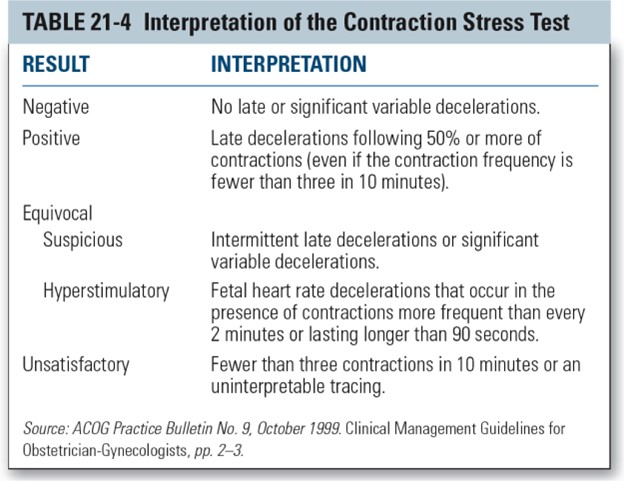
A nurse is caring for a client who is scheduled for an amniocentesis at 35 weeks of gestation to assess fetal lung maturity.
Which of the following laboratory tests will provide this information?
Explanation
Lecithin/sphingomyelin (L/S) ratio.
This is a test that measures the amount of two phospholipids in the amniotic fluid that are important for the production of surfactant, a substance that helps the lungs expand and prevents them from collapsing.A higher L/S ratio indicates more surfactant and greater fetal lung maturity.The normal range for L/S ratio is 2:1 or higher at term.
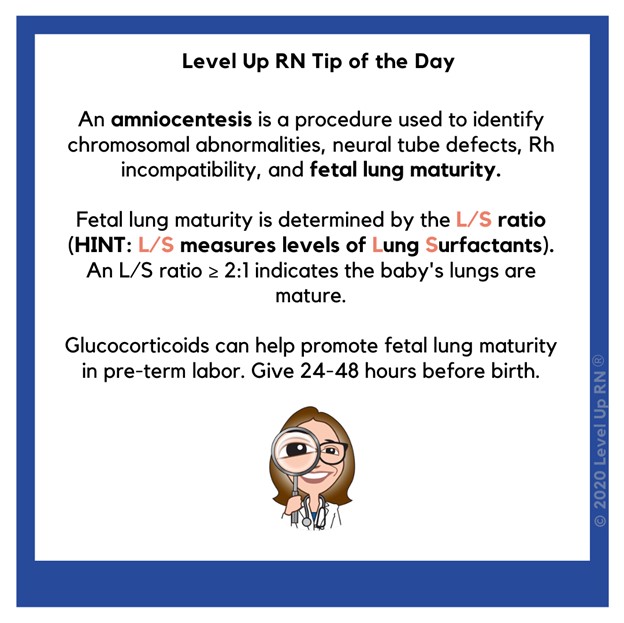
Choice A is wrong because alpha-fetoprotein (AFP) is a protein produced by the fetus that can be measured in the amniotic fluid or maternal blood.It is used to screen for neural tube defects and other abnormalities, not for fetal lung maturity.
Choice C is wrong because Kleihauer-Betke test is a blood test that detects fetal red blood cells in the maternal circulation.It is used to diagnose fetomaternal hemorrhage, a condition where fetal blood leaks into the mother’s blood, not for fetal lung maturity.
Choice D is wrong because indirect Coombs’ test is a blood test that detects antibodies in the mother’s blood that may attack the fetal red blood cells.It is used to screen for Rh incompatibility or other blood group sensitization, not for fetal lung maturity.
A nurse is reviewing the findings of a biophysical profile (BPP) for a client who is at 40 weeks of gestation.
The BPP score is 6 out of 10 points.
Which of the following components are included in this score? (Select all that apply.)
Explanation
The correct answer is choice A, B, C and D.These are the four components of a biophysical profile (BPP) that are scored as 2 (normal) or 0 (abnormal) based on ultrasound examination.The fifth component is the nonstress test (NST) that measures the fetal heart rate reactivity.A total score of 8 or 10 is normal, 6 is equivocal, and 4 or less is abnormal.
Choice E is wrong because fetal position is not a part of the BPP score.Fetal position is determined by ultrasound but it does not affect the score.
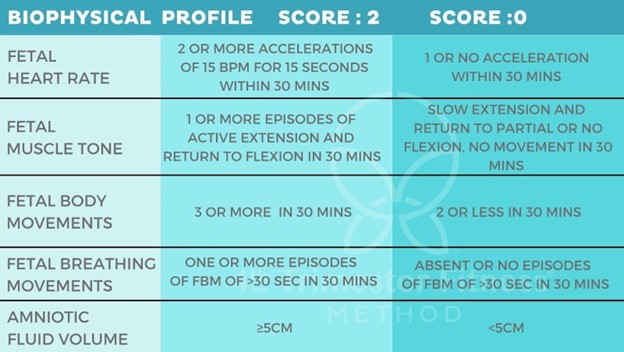
Normal ranges for each component are:
• Fetal breathing movement: One or more episodes of fetal breathing lasting at least 30 seconds within 30 minutes.
• Fetal tone: One or more episodes of active extension and flexion of a fetal extremity or opening and closing of the hand within 30 minutes.
• Reactive fetal heart rate: Two or more fetal heart rate accelerations that peak at least 15 beats per minute above the baseline and last at least 15 seconds from baseline to baseline during 20 minutes of observation.
• Amniotic fluid volume: A single deepest vertical pocket of amniotic fluid that measures at least 2 centimeters.
• Gross body movement: Three or more discrete body or limb movements within 30 minutes.
A nurse is caring for a client who is undergoing an external nonstress test at 40 weeks of gestation and notes variable decelerations on the fetal monitor tracing that are unresponsive to interventions such as repositioning and oxygen administration.
Which of the following actions should the nurse take next?
Explanation
Prepare the client for an amnioinfusion.An amnioinfusion is a procedure that adds fluid to the uterus during labor to relieve cord compression and improve fetal condition.Variable decelerations on the fetal monitor tracing are a sign of cord compression and fetal distress.If repositioning and oxygen administration do not resolve the decelerations, an amnioinfusion may be indicated.
Choice B is wrong because applying an internal fetal scalp electrode does not address the cause of variable decelerations, which is cord compression.
An internal fetal scalp electrode is used to monitor the fetal heart rate more accurately, but it does not improve fetal oxygenation or prevent cord compression.
Choice C is wrong because administering IV fluid bolus to the client may help increase maternal blood volume and placental perfusion, but it does not directly increase amniotic fluid volume or relieve cord compression.
Choice D is wrong because discontinuing oxytocin infusion if present may reduce uterine contractions and decrease cord compression, but it may also prolong labor and increase the risk of infection or fetal compromise.Oxytocin infusion should only be discontinued if there are signs of uterine hyperstimulation or fetal intolerance.
A nurse is performing an external nonstress test for a client who is at 41 weeks of gestation and has oligohydramnios.
The nurse notes that there are no accelerations in the fetal heart rate tracing after applying an acoustic stimulator to the maternal abdomen for several seconds.
Which of the following actions should the nurse take?
Explanation
Notify the provider and prepare for delivery.Oligohydramnios is a condition where the amniotic fluid volume is less than expected for gestational age and it is associated with maternal and fetal complications.
The nonstress test (NST) is a method of fetal surveillance that measures the fetal heart rate response to fetal movement.A reactive NST is defined as at least two accelerations of 15 beats per minute or more above the baseline, lasting 15 seconds or more, within a 20-minute period.
A nonreactive NST indicates fetal hypoxia or acidosis and requires further evaluation.An acoustic stimulator can be used to elicit fetal movement and accelerations, but it should not be repeated more than once in a 10-minute period.
Therefore, choice A is wrong because repeating the acoustic stimulation after 1 minute is too soon and may cause fetal distress.
Choice B is wrong because documenting the finding as a nonreactive NST is not enough to address the situation.Choice C is wrong because performing a contraction stress test (CST) is contraindicated in oligohydramnios because it may cause umbilical cord compression and fetal compromise.
The CST involves inducing uterine contractions with oxytocin or nipple stimulation and monitoring the fetal heart rate for signs of intolerance.
A negative CST means that there
A nurse is interpreting the results of a contraction stress test (CST) for a client who is at 38 weeks of gestation.
The nurse notes that there are no late or significant variable decelerations of the fetal heart rate (FHR).
How should the nurse document this finding?
Explanation
Negative CST.A negative CST means that the fetal heart rate does not slow down (decelerate) after a contraction, which indicates that the baby can tolerate the stress of labor.
This is a normal and reassuring result.
Choice A is wrong because a positive CST means that the fetal heart rate slows down and stays slow after more than half of the contractions, which indicates that the baby may be at risk for problems during labor.
This is an abnormal and concerning result.
Choice C is wrong because an unsatisfactory CST means that there are not enough contractions to produce a reliable result.
This may happen if the medication or nipple stimulation does not induce enough contractions, or if there are other factors that interfere with the test, such as maternal movement or fetal sleep.
Choice D is wrong because a suspicious CST means that the results are unclear or inconsistent.This may happen if the fetal heart rate slows down after some but not all of the contractions, or if there are other types of decelerations that are not clearly related to the contractions.
A suspicious CST may need to be repeated in a couple of days.
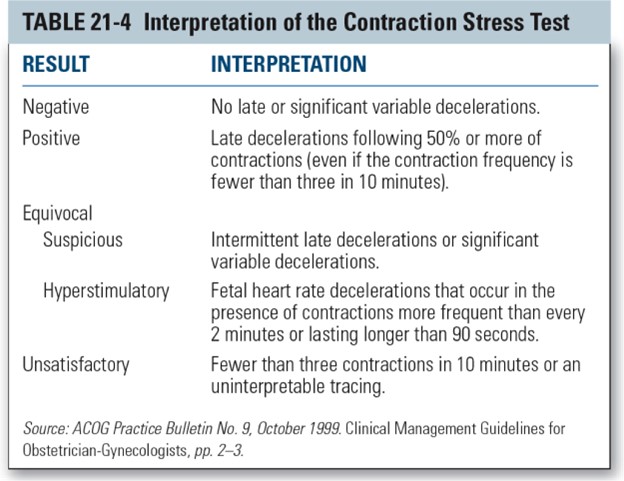
A nurse is caring for a client who is undergoing an oxytocin-stimulated contraction stress test (CST).
The nurse observes three contractions in 10 minutes with no late decelerations of the fetal heart rate (FHR).
Which of the following actions should the nurse take?
Explanation
Maintain oxytocin infusion and monitor the client until a negative CST result is confirmed.
A negative CST result means that there are no late decelerations of the FHR after three contractions in 10 minutes.This indicates that the fetus can tolerate the stress of labor and has adequate oxygenation.
Choice A is wrong because discontinuing oxytocin infusion and monitoring the client for another 10 minutes will not provide enough information about the fetal response to contractions.The test requires at least three contractions in 10 minutes to be valid.
Choice B is wrong because increasing oxytocin infusion and monitoring the client until four contractions occur in 10 minutes may cause uterine hyperstimulation, which can compromise fetal oxygenation and lead to fetal distress.
Choice C is wrong because stopping oxytocin infusion and notifying the provider of a positive CST result is not appropriate.A positive CST result means that there are late decelerations of the FHR after more than half of the contractions, indicating fetal hypoxia and placental insufficiency.
In this case, there are no late decelerations, so the test result is not positive.
A nurse is providing discharge instructions to a client who had a nonreactive nonstress test (NST) followed by a biophysical profile (BPP) with a score of 8/10.
Which of the following statements by the client indicates an understanding of the teaching?
Explanation
The client should count the baby’s kicks every day to monitor fetal well-being.A nonreactive nonstress test (NST) indicates that the fetal heart rate did not increase adequately with fetal movement, which may suggest fetal hypoxia or distress.A biophysical profile (BPP) is a combination of NST and ultrasound that assesses five parameters: fetal breathing, movement, tone, amniotic fluid volume, and NST.
Each parameter is scored 0 or 2, and the total score ranges from 0 to 10.A score of 8/10 or 10/10 is considered normal, while a score of 6/10 is equivocal and ≤ 4/10 is abnormal.A BPP score of 8/10 with a nonreactive NST means that the fetus has normal biophysical activities but may have chronic hypoxia.
Choice A is wrong because the client does not need to have another BPP in a week unless there are other indications of fetal compromise.The BPP may be repeated once or twice a week depending on the clinical situation.
Choice C is wrong because the client does not need to have an amniocentesis as soon as possible.
Amniocentesis is an invasive procedure that involves inserting a needle into the uterus to obtain amniotic fluid for analysis.It is usually done for prenatal diagnosis of genetic disorders or fetal lung maturity, not for fetal well-being.
Choice D is wrong because the client does not need to deliver the baby by cesarean section.Cesarean section is a surgical delivery that may be indicated for various maternal or fetal conditions, such as placenta previa, breech presentation, fetal distress, or failure to progress in labor.A BPP score of 8/10 with a nonreactive NST does not warrant a cesarean section unless there are other risk factors or complications.
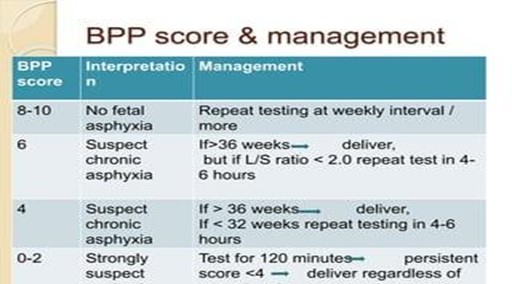
A nurse is caring for a client in labor who has an internal fetal scalp electrode applied for continuous fetal heart rate (FHR) monitoring.
The nurse notes a pattern of late decelerations on the FHR tracing.
What is the priority nursing intervention?
Explanation
Notify the health care provider.Late decelerations are a sign of uteroplacental insufficiency, which means that the blood flow and oxygen supply to the placenta and the fetus are compromised.This is a serious condition that can lead to fetal hypoxia and acidosis.The priority nursing intervention is to inform the health care provider who can assess the situation and decide on the appropriate course of action, such as delivery by cesarean section.
Choice A is wrong because changing the client’s position may not improve the blood flow to the placenta if there is a problem with the placenta itself, such as placental abruption.
Choice B is wrong because administering oxygen via face mask may not be enough to correct the fetal hypoxia caused by uteroplacental insufficiency.
Choice C is wrong because increasing intravenous fluid rate may not improve the blood flow to the placenta if there is a problem with the maternal blood pressure, such as hypotension from epidural analgesia.
A nurse is assessing a fetal heart rate (FHR) tracing for a client who is in active labor.
The nurse notes that the baseline FHR is 150 bpm with absent variability and recurrent variable decelerations with slow return to baseline.
What category of FHR tracing does this represent?
Explanation
Category III.This category of FHR tracing represents an abnormal pattern that is predictive of fetal acidemia and requires prompt evaluation and intervention.A category III pattern is defined by any of the following criteria:
• Absent baseline FHR variability and any of the following:
➤ Recurrent late decelerations
➤ Recurrent variable decelerations
➤ Bradycardia
• Sinusoidal pattern
Choice A is wrong because category I is a normal pattern that is predictive of normal fetal acid-base balance at the time of observation.A category I pattern is defined by all of the following criteria:
• Baseline rate of 110 to 160 bpm
• Moderate baseline FHR variability
• No late or variable decelerations
• Early decelerations may be present or absent
• Accelerations may be present or absent
Choice B is wrong because category II is an indeterminate pattern that is not predictive of abnormal fetal acid-base balance but requires continued surveillance and reevaluation.A category II pattern includes all FHR tracings that are not category I or III.
Choice D is wrong because there is no category IV in the NICHD classification system for FHR tracings.
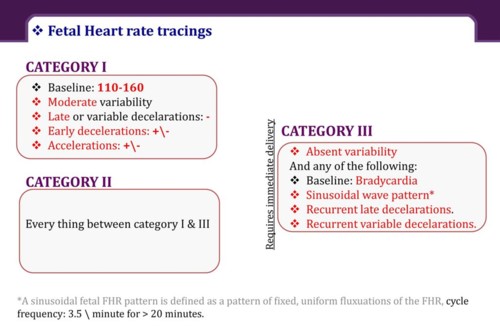
(Select all that apply) A nurse is performing a nonstress test (NST) for a client who is at 32 weeks of gestation and has gestational diabetes mellitus.
The nurse uses vibroacoustic stimulation to elicit fetal movement and acceleration of FHR.
What are the indications for using this method?
Explanation
The test result is nonreactive after 40 minutes.Vibroacoustic stimulation (VAS) is the application of a vibratory sound stimulus to the abdomen of a pregnant woman to induce fetal heart rate (FHR) accelerations.VAS is typically used during a nonstress test (NST) to elicit fetal movement and reactivity when the baseline FHR variability is minimal or the test result is nonreactive after 40 minutes.VAS can shorten the testing time and reduce the incidence of non-reactive cardiotocography.
Choice A is wrong because the fetus’s presentation does not affect the use of VAS.
Choice B is wrong because VAS is not indicated for a fetus that has not moved for 40 minutes, unless the NST result is also nonreactive.
Choice C is wrong because minimal baseline FHR variability is not a sufficient indication for VAS, unless the NST result is also nonreactive.
Choice D is wrong because a history of stillbirth does not affect the use of VAS.
A nurse is using vibroacoustic stimulation (VAS) to stimulate fetal movement during a nonstress test (NST).
What action should the nurse take when applying VAS?
Explanation
Place the device over the fetal back for 3 seconds.This is because vibroacoustic stimulation (VAS) is the application of a vibratory sound stimulus to the abdomen of a pregnant woman to induce fetal heart rate (FHR) accelerations.The presence of FHR accelerations reliably predicts the absence of fetal metabolic acidemia.VAS is typically used during a nonstress test (NST) to assess fetal well-being.The device should be placed over the fetal back for 3 seconds, as this is the optimal duration and location to elicit a fetal response.
Choice B is wrong because holding the device firmly against the maternal abdomen for 10 seconds may be too long and too strong for the fetus, and may cause discomfort or distress.
Choice C is wrong because moving the device around the maternal abdomen until fetal movement is detected may not be effective or efficient, as the device may not reach the optimal location or duration to stimulate the fetus.
Choice D is wrong because applying the device intermittently over the fundus for 15 seconds may not target the fetal auditory system, which is located near the fetal back, and may also be too long and too strong for the fetus.
Normal ranges for FHR are between 110 and 160 beats per minute, and FHR accelerations are defined as an increase of at least 15 beats per minute above baseline for at least 15 seconds.
A nurse is evaluating the results of a contraction stress test (CST) for a pregnant client who had a nonreactive or nonreassuring result on a nonstress test (NST).
The nurse notes that there are no late decelerations of the fetal heart rate (FHR) after three contractions in a 10-minute period.
How should the nurse interpret this finding?
Explanation
Negative or normal.This means that there are no late decelerations of the fetal heart rate (FHR) after three contractions in a 10-minute period, which indicates that the baby can tolerate the stress of labor contractions.
Choice A is wrong because positive or abnormal results mean that there are late decelerations of the FHR after three contractions in a 10-minute period, which suggests that the baby may be at risk of hypoxia or injury during labor.
Choice C is wrong because equivocal or suspicious results mean that there are either variable decelerations or late decelerations after fewer than half of the contractions, which require further testing or monitoring.
Choice D is wrong because unsatisfactory or incomplete results mean that there are either fewer than three contractions in a 10-minute period or poor quality of the FHR tracing, which prevent an accurate interpretation of the test.
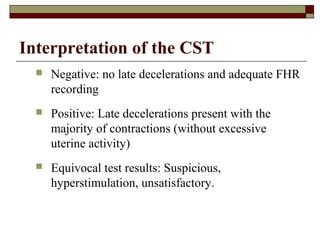
A nurse is comparing nonstress test (NST) and contraction stress test (CST) for assessing fetal well-being.
What is an advantage of NST over CST?
Explanation
NST is less time-consuming and more comfortable than CST.This is because NST does not require any external stimulation of the uterus, while CST involves giving oxytocin to induce contractions.NST also does not pose any risk of preterm labor or fetal distress, which are possible complications of CST.
Choice A is wrong because NST does not provide more information about fetal status than CST.In fact, CST can detect fetal hypoxia more accurately than NST.
Choice C is wrong because NST does not have fewer contraindications than CST.Both tests have similar contraindications, such as placenta previa, multiple gestation, and previous cesarean section.
Choice D is wrong because NST does not have higher sensitivity and specificity than CST.
Sensitivity refers to the ability of a test to correctly identify positive cases, while specificity refers to the ability of a test to correctly identify negative cases.
NST has a high sensitivity but a low specificity, meaning it can detect most fetuses with hypoxia but also has many false positives.CST has a low sensitivity but a high specificity, meaning it can miss some fetuses with hypoxia but also has few false negatives.
Sign Up or Login to view all the 14 Questions on this Exam
Join over 100,000+ nursing students using Nursingprepexams’s science-backend flashcards, practice tests and expert solutions to improve their grades and reach their goals.
Sign Up Now

